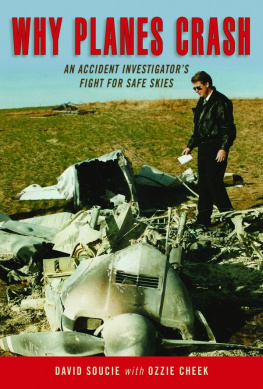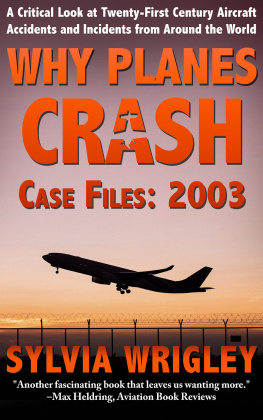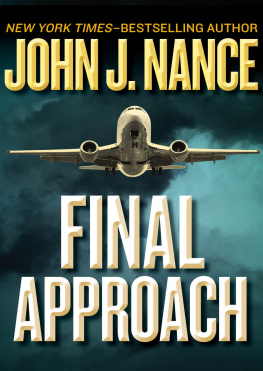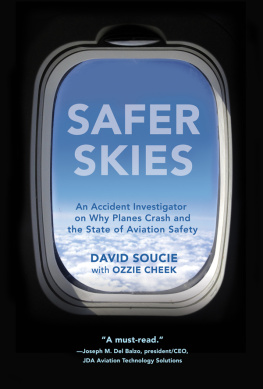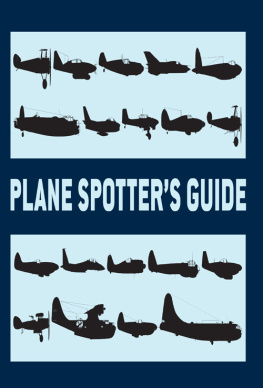Plane Crash
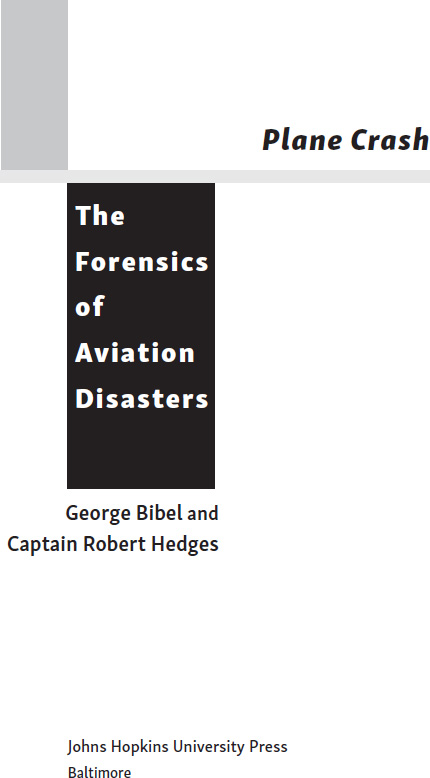
2018 Johns Hopkins University Press
All rights reserved. Published 2018
Printed in the United States of America on acid-free paper
9 8 7 6 5 4 3 2 1
Johns Hopkins University Press
2715 North Charles Street
Baltimore, Maryland 21218-4363
www.press.jhu.edu
Library of Congress Cataloging-in-Publication Data
Names: Bibel, G. D. (George D.), author. | Hedges, Robert, 1964 author.
Title: Plane crash : the forensics of aviation disasters / George Bibel and Captain Robert Hedges.
Description: Baltimore : Johns Hopkins University Press, [2018] | Includes bibliographical references and index.
Identifiers: LCCN 2017021044| ISBN 9781421424484 (hardcover : alk. paper) | ISBN 9781421424491 (electronic) | ISBN 1421424487 (hardcover : alk. paper) | ISBN 1421424495 (electronic)
Subjects: LCSH: Aircraft accidentsInvestigation. | Aircraft accidentsCase studies.
Classification: LCC TL553.5 .B5222 2018 | DDC 363.12/465dc23 LC record available at https://lccn.loc.gov/2017021044
A catalog record for this book is available from the British Library.
Special discounts are available for bulk purchases of this book. For more information, please contact Special Sales at 410-516-6936 or .
Johns Hopkins University Press uses environmentally friendly book materials, including recycled text paper that is composed of at least 30 percent post-consumer waste, whenever possible.
To the two greatest teachers with whom I have studied: my father, Dr. James S. Hedges, who taught me the love of reading, and Dr. John E. Kiser, who taught me the love of writing
Bob Hedges
Preface
In spite of writing a book about aviation mishaps, we want to stress that commercial aviation is by far the safest mode of transportation, and it is becoming safer all the time, in part because of comprehensive accident analysis. Today, commercial flight is so safe that airlines practically have to invent a new sequence of events to crash a plane. Most of the accident scenarios in this book are exceedingly rare if not downright unique. A thorough investigation and implementation of remedial actions significantly reduce the probability of an already remote event repeating.
This is a science book that tells stories, or a storybook that teaches science. The airplane accidents discussed here have been selected both because they touch on well-documented (and understandable) science and because they are compelling and interesting stories. Surprisingly, most accidents are survivable because planes typically crash from lower altitudes and speeds associated with a less-than-perfect takeoff or landing.
This book is a companion to my previous book, Beyond the Black Box: The Forensics of Airplane Crashes. It describes all new accidents and includes important contributions from an experienced airline pilot.
We are both interested in how things work on the airplane, or how things do not work during accident scenarios. Airliner performance is also of interest. Information is highly proprietary, yet data leak out in the accident reports. The book is organized around the phases of flight: takeoff, climb, cruise, approach, and landing. A disproportionate number of events from the cruise phase are presented, not because they are most common but because they are most interesting.
Introducing Captain Hedges
Robert Hedges is a Captain, line check airman, and instructor at a major US airline. Bob took his first flying lesson at the age of 14 and flew light aircraft throughout high school and college. He graduated from the University of North CarolinaCharlotte in 1986 with a degree in biology. He attended US Air Force Undergraduate Pilot Training at Williams Air Force Base, Arizona, flying the T-37 and T-38, and he subsequently flew and instructed in the C-9A (a military DC-9 used for aeromedical transportation) at Scott Air Force Base, Illinois. After leaving the USAF, he started his airline career as a B-727 Flight Engineer (Second Officer) in 1991. In the 25 years since then, he has flown and instructed in numerous aircraft, including the Airbus A320, McDonnell Douglas DC-9 and MD-80 series, Boeing B-727, B-737, B-747-400, B-757, and B-767, and the Lockheed L-1011. He has amassed over 15,000 hours of flying time and another 3,800 hours instructing in the simulator.
Bob has always had a keen interest in safety and has taught classes on human factors, crew resource management, and threat and error management. He has a master of aeronautical science degree with distinction and a graduate certificate in aviation/aerospace safety systems from Embry-Riddle Aeronautical University. Bob has taught a variety of aerospace courses at the graduate level, and he has instructed pilots from more than 30 airlines worldwide. In addition to flying and teaching in the classroom, simulator, and aircraft, he has also been a check airman, a line check airman, and a designated pilot examiner for the Federal Aviation Administration (FAA).
Bob holds the following FAA certificates and ratings: Airline Transport Pilot, Airplane Single and Multiengine Land, A320, B-727, B-747-4[00], B-757, B-767, DC-9, and L-1011. He also holds Certified Flight Instructor and Flight Engineer-Turbojet certificates. He has been the production manager of a chemical manufacturing plant; studies industrial safety in the aviation, maritime, chemical processing, and nuclear power industries; and is a member of the American Nuclear Society. He enjoys researching and writing about aerospace history and safety, with particular interest in the F-105, L-1011, and the Apollo programs.
Although the book is focused on science, Captain Hedges, being a pilot, is more attuned to what is commonly called human factorsfactors related to human error. With invaluable review and comments, Captain Hedges contributions to this book greatly exceeded the words he wrote.
George Bibel
Plane Crash
1 Takeoff!
With just one plane, MK Airlines began operations in 1990. Their mission was to fly fresh pineapples from Africa to Europe. With business growing 30% annually, the company was adding nearly one plane each year. By 2004, MK Airlines had expanded to twelve planessix Boeing 747s and six DC-8s. Retired passenger planes are often repurposed as cargo planes. The Douglas DC-8, introduced in 1959, was last manufactured in 1972.
On October 14, 2004, MK Airlines Flight 62, a Boeing 747-200 manufactured in 1980, took off from Halifax, Nova Scotia, shortly before 4:00 a.m. The plane crashed just outside the airport security perimeter. Air traffic controllers saw a fireball and activated the crash alarm. Fire trucks arrived on the scene in about five minutes, and 60 firefighters spent five hours putting out the main fire. The entire crew of seven was killed.
The plane clipped treetops and utility poles and cut off electric power to the airport. Emergency generators automatically restored power within a few seconds. The control tower, with its own power supply (and backup system), didnt miss a beat.
First reports of an explosion occurring before the crash did not pan out. Nevertheless, Canadian police took charge of the initial investigation. Eyewitness accounts reported the next day: The aircraft basically didnt take off. She continued her [takeoff run] and ran off the runway and ran into the woods.
Security videos did not support this version of events.
It was soon established that the tail struck the runway twice and dragged, and then broke off after striking an earthen berm located 1,150 feet past the end of the runway. Mounted on a concrete slab on top of the berm were the antennas for the instrument landing system. The berm was 11.6 feet high. Because of ground slope, the top of the berm was the same height as the end of the runway. (The earthen berm met all airport certification standards and was not considered a factor in the investigation.) Per mandated rules that define a safe takeoff, the lowest part of the plane (the extended landing gear) must be at least 35 feet off the ground by the end of the runway. Takeoff parameters are calculated to meet this 35-foot requirement.
Next page

